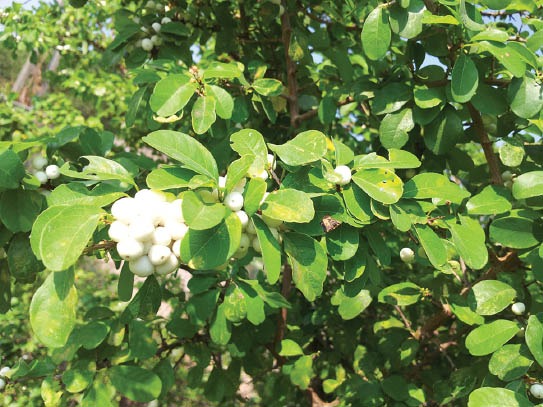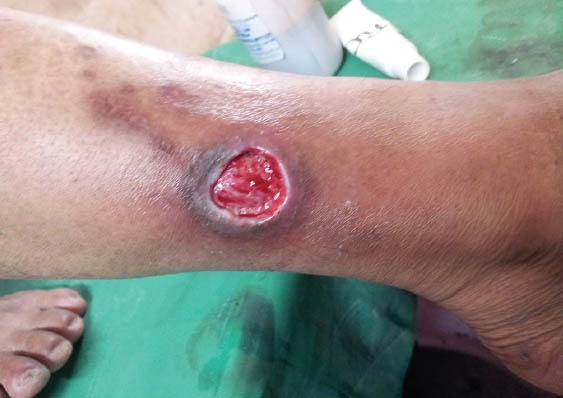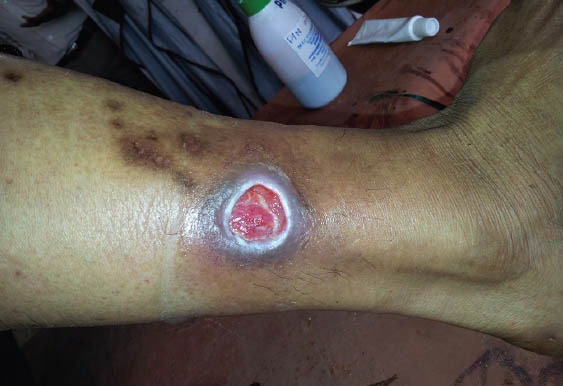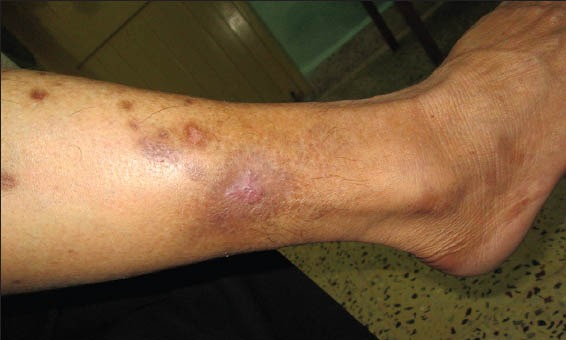Abstract
In acute and chronic wounds, Katupila (Securinega leucopyrus) (Willd.) Muell is a commonly used folklore remedy in Sri Lanka and Saurashtra region of India. We report a case of Madhumehajanya Dushta Vrana (chronic diabetic wound) that was treated with local application of S. leucopyrus in paste form once daily. Wound healed within a month with normal pigmentation and minimal scar. This case also demonstrated possible antimicrobial potential in the treatment of Dushta Vrana.
Keywords: Diabetic wound, Dushta Vrana, Katupila, Securinega leucopyrus
INTRODUCTION
Now-a-days diabetes mellitus and its complications like a non-healing wound is a challenge to the surgeon. In diabetic patients, wounds are critical, difficult to heal and often prone to infection. The impaired healing might be due to glucose laden tissue, atherosclerotic changes and peripheral neuritis. Diabetic wounds might end in the amputation of the limb, if not treated properly. It was estimated that in 2012 approximately 370 million people have diabetes, i.e., 8.3% of the world's population and in every 20 seconds a lower limb is lost due to diabetes globally.[1] Majority of these amputations are preceded by non-healing ulcers. Only two-thirds of ulcers eventually heal and one-third may result in some form of amputation. In Ayurveda, herbal or herbo-mineral formulations are suggested for wound healing, but available evidences on diabetic wound healing are limited.[2,3,4]
Though there are many advances in modern surgery, management of diabetic wounds is still posing a problem to the surgeons. Patients prefer Ayurveda treatment as a last choice.
Acharya Sushruta explained 60 measures for the management of Vrana (wounds), which shows unique therapeutic approach for management of wounds. Securinega leucopyrus is a desert climatic plant found in wet climates in Sri Lanka known as Katupila. It is known as Humari or Paanduraphalika in the Indian Sub-continent also called as “Spinous fluggea” in English[5] [Figure 1]. It consists of qwasitrin, albumin, resins and coloring agents. Katupila possesses kashaya and Tikta rasas; Lagu, Ruksha, Tikshna gunas; Ushna veerya and Katu vipaka. Katupila leaves act as an antiseptic and its paste is used in folklore to extract any extraneous materials from body tissues without surgery.[6] Sesame oil has Vrana Shodhan (wound cleaning) and Vrana Dahanashaka (relief in burning pain) properties,[7] was used along with the paste. We report a case of diabetic wound, which healed within a month after the application of Katupila without any adverse effects.
Figure 1.

The Shrub Katupila (Securinega leucopyrus) branches and with whitish fruits
CASE REPORT
A 55-year-old male diabetic patient of Pitta-Kaphaja Prakriti presented to us in Shalya Tantra Out-Patient Department for treatment of infected diabetic wound at mid lateral tibial aspect of the right lower limb. Patient complained of burning pain in the wound, foul-smelling pus discharge, difficulty in walking and occasional fever. On examination, a large (4.5 cm × 4 cm × 2 cm) gangrenous and round shaped ulcer was noted at the right lower leg. There was foul-smelling pus discharge and local swelling with necrosed subcutaneous tissue and skin [Figure 2]. Symptoms were existing since a month and became severe with necrosis since 7 days. Patient had Type II diabetes mellitus since last 15 years and taking antidiabetic medicines irregularly. He had been treated by the general practitioner for wound, but did not have any relief as he discontinues the antidiabetic treatment. Laboratory investigations for total leukocyte count, differential leukocyte count, hemoglobin blood urea and serum creatinine were in the normal range while blood sugar was found elevated (fasting blood sugar [FBS] - 228 and postprandial blood sugar [PPBS - 340]). Patient was admitted in male Shalya ward for further investigations and management.
Figure 2.

Dushta Vrana (diabetic wound) on the anterior lateral aspect of the right leg before treatment at the first consultation on 28-04-2012
Application of the paste
Dried leaves of Katupila were powdered and made into paste by adding sesame oil and applied on the wound.
OBSERVATIONS
Patient was treated with local application of Katupila paste daily and observed for improvement at regular intervals. The wound was cleaned with freshly prepared Panchavalkala kwath and Katupila paste mixed with sesame oil was applied in adequate quantity. The wound was covered with sterile gauze and loosely bandaged once daily in the morning. Changes in the symptoms like pain, tenderness, color, discharge, odor, etc., were observed at regular intervals. After 3 days, the application of paste, the necrosed skin and subcutaneous part of the wound was removed without surgical debridement. The swelling and redness also reduced remarkably. Dressing continued with Katupila paste. On 7th day, there was fresh granulation tissue without any swelling and slough [Figure 3]. On 15th day, fresh contracting margins appeared as a sign of wound healing. The filling of the wound base with fresh and well-vasculated tissues and healthy granulation was seen on the wound surface [Figure 4]. Tablet metformin 500 mg once daily before the meal was continued as anti-diabetic management, which was prescribed by the physician. After one month, the wound was healed completely with normal pigmentation and minimum scar [Figure 5]. The blood sugar after completion of treatment was within the normal limits (FBS - 110 mg/dl and PPBS - 140 mg/dl).
Figure 3.

Fresh wound after 7 days with mild swelling on 05-05-2012
Figure 4.

Healing wound with fresh contracting margins and healthy granulation tissue on 12-05-2012
Figure 5.

Completely healed wound with the normal pigmentation on 27-05-2012
DISCUSSION
The signs of Dushta Vrana (chronic wound) mentioned in the classics are Ativivrita (broad base), Bhairava (ugly look), Putipuyamansa (pus discharge), Gandha (foul smell), Vedana (pain), Dirghakalanubandhi (chronicity).[8] In this case, almost all these signs were observed was correlated with “Dushta Vrana.” Sushruta mentioned prognosis of diabetic wound as “krichrasadhya” (difficult to treat), which is experienced even in today's practice.[9] According to Acharya Sushruta among the 60 measures of wound treatment, “Kalka” (application of paste) is a measure indicated for non-healing wounds located in muscle and having slough. The paste performs both functions of “Shodhana” (cleaning) and “Ropana” (healing) in Dushta Vrana.[10] Katupila has Kashaya rasa which provides Lekhana (scraping) that helps to slough out necrosed tissue and preparing the wound for healing. Kashaya rasa has Grahi and Stambhana properties which helped to stop discharge from the wound.[11]
At the time of first consultation, the patient had pain, discharge, black coloration of wound surface, redness and swelling at the surrounding area with predominating Vata, Kapha and Pitta Dosha. The Tikta rasa of the Katupila and Snigdha guna of sesame oil reduced the vitiated Thridosha leading to relief in pain and enhanced wound healing. Katupila has been emphasized for its antimicrobial, antiseptic and wormicidal properties. These properties assisted in cleaning the wound and help to inhibit the growth of microorganisms. Antioxidant activity of Katupila seems due to the presence of flavonoids, tannins in abundant quantity.[12] Katupila not only scavenges off the free radicals, but also inhibits the generation of free radicals.[13] No adverse event was noticed throughout the treatment and the healing occurred uneventfully. The treatment was found to be cost-effective, safe and easy to implement. During the treatment antidiabetic drug (metformin 500 mg) was continued, which also contributed to heal the wound by controlling blood sugar. As diabetic wounds are difficult to heal only with local treatment, additional anti-diabetic drug might have helped in early healing. Metformin is also known to increase angiogenesis, which is essential for wound healing.[14]
The wound was treated with application of paste and observed that after 3 days, necrosed tissue was removed automatically and swelling, redness, bad odor relieved within 7 days which indicates that the drug has the property to debride the dead tissue. The wound became fresh having healthy granulation and good looking within 15 days which showed that applied drug prevents infection. Wound healed completely within 30 days with minimum scar, which proves the “Savarnikarana” (producing normal skin color) effect of Katupila.
CONCLUSION
This case demonstrated that Katupila paste has potential to heal the infected diabetic wound. This observation needs to be studied in more patients to explore better options for diabetic wound management.
ACKNOWLEDGMENT
The authors would like to thank Prof. M. S. Baghel, Director, IPGT and RA, Gujarat Ayurved University, Jamnagar.
Footnotes
Source of Support: Nil,
Conflict of Interest: None declared.
REFERENCES
- 1.Diabetic Foot International Diabetes Federation (IDF) International Working Group on the diabetic foot. [Last accessed on 2013 May 10]. Available from: http://www.iwgdf.org .
- 2.Sathish HS, Baghel MS, Bhuyan C, Gupta SK, Dudhamal TS. Review of clinical observational studies conducted on tissue healing at IPGT and RA Jamnagar. Int J Res Ayurveda Pharm. 2011;2:13–7. [Google Scholar]
- 3.Datta HS, Mitra SK, Patwardhan B. Wound healing activity of topical application forms based on ayurveda. Evid Based Complement Alternat Med. 2011:1–10. doi: 10.1093/ecam/nep015. [DOI] [PMC free article] [PubMed] [Google Scholar]
- 4.Biswas TK, Maity LN, Mukherjee B. Wound healing potential of Pterocarpus santalinus linn: A pharmacological evaluation. Int J Low Extrem Wounds. 2004;3:143–50. doi: 10.1177/1534734604268385. [DOI] [PubMed] [Google Scholar]
- 5.Santhapu H. Plants of Saurashtra a Preliminary List. Rajkot: S.J.F.N.I. Saurashtra Research Society; 1953. Humari (Securinega leucopyrus) [Google Scholar]
- 6.Bakshu LM, Jeevan Ram A, Venkata Raju R. Antimicrobial activity of Securinega leucopyrus. Fitoterapia. 2001;72:930–3. doi: 10.1016/s0367-326x(01)00341-0. [DOI] [PubMed] [Google Scholar]
- 7.Shastri A. Dravadravyavidhi Adhyaya. 12th ed. Ch 45, Verse 112. Varanasi: Chaukhambha Sanskrita Sansthan; 2001. Commentary Ayurveda Tatva Sandipika on Susruta Samhita of Sushruta, Sutra Sthana; pp. 178–9. [Google Scholar]
- 8.Shastri A. Vranasravavidnyaniya Adhyaya. 12th ed. Ch 22, Verse 7. Varanasi: Chaukhambha Sanskrita Sansthan; 2001. Commentary Ayurveda Tatva Sandipika on Susruta Samhita of Sushruta, Sutra Sthana; p. 95. [Google Scholar]
- 9.Shastri A. Vranasravavidnyaniya Adhyaya. 12th ed. Ch 23, Verse 7. Varanasi: Chaukhambha Sanskrita Sansthan; 2001. Commentary Ayurveda Tatva Sandipika on Susruta Samhita of Sushruta, Sutra Sthana; p. 98. [Google Scholar]
- 10.Shastri A. Dwivraniya Adhyaya. 12th ed. Ch 1, Verse 55. Varanasi: Chaukhambha Sanskrita Sansthan; 2001. Commentary Ayurveda Tatva Sandipika on Susruta Samhita of Sushruta, Chikitas Sthana; p. 8. [Google Scholar]
- 11.Pandit Mishra BS, Vaidya Bhavamishra SR, Bhaavprakaasha Mishraprakaranam. 8th ed. Ch. 6, Verse 192. Varanasi: Chaukhambha Sanskrit Bhawan; 2007. p. 187. [Google Scholar]
- 12.Ajmeer AS, Harisha CR, Dudhamal TS, Gupta SK. Micromorphological and micrometric evaluation of Securinega leucopyrus (Willd.) Muell. leaf and stem-unexplored drug. Int J Sci Invent Today. 2013;2:140–9. [Google Scholar]
- 13.Megha G. In-vitro anti-arthritic activity of aerial parts of Securinega leucopyrus (willd) muell, Euphorbiaceae SRMC and RI, Porur PT-066. [Last accessed on 2013 Mar 30]. Available from: http://www.jsscpooty.org/assets/pdf/Selected-List-Category-C.pdf .
- 14.Ambrish C, Torgal SS, Patil PA, Malur PR, Hiremath SV. Influence of oral anti-diabetic agents on wound healing in euglycemic male Wister rats. Pharmacologyonline. 2009;1:476–83. [Google Scholar]


